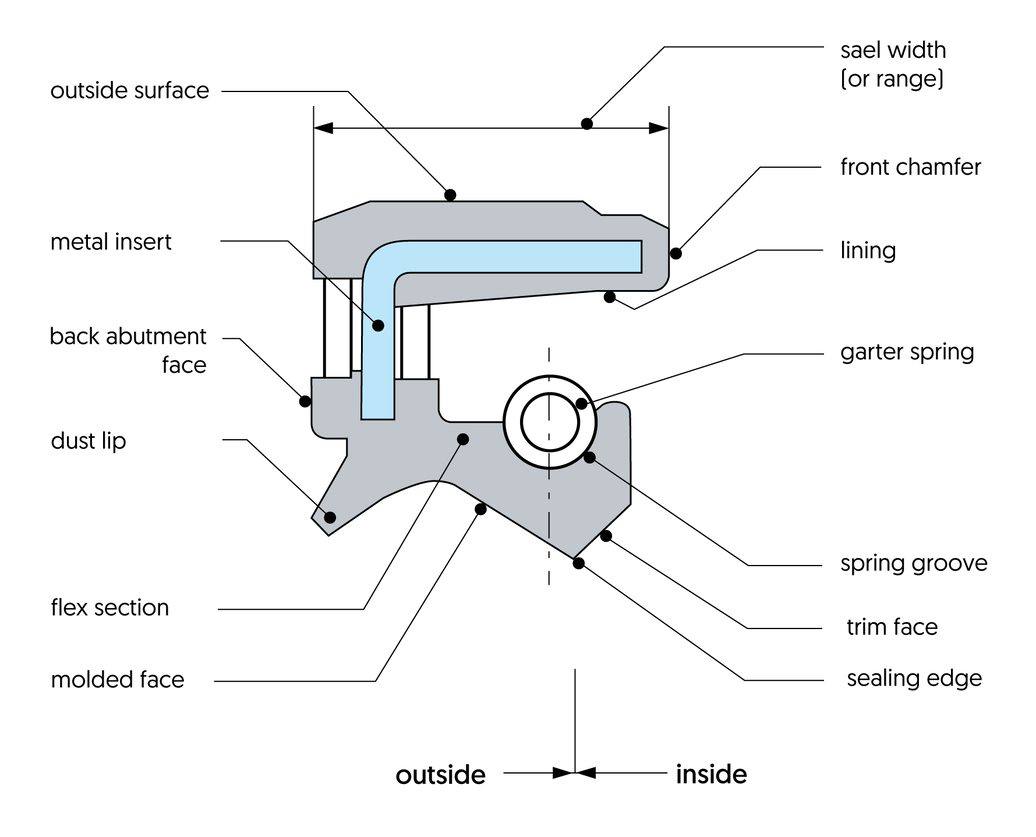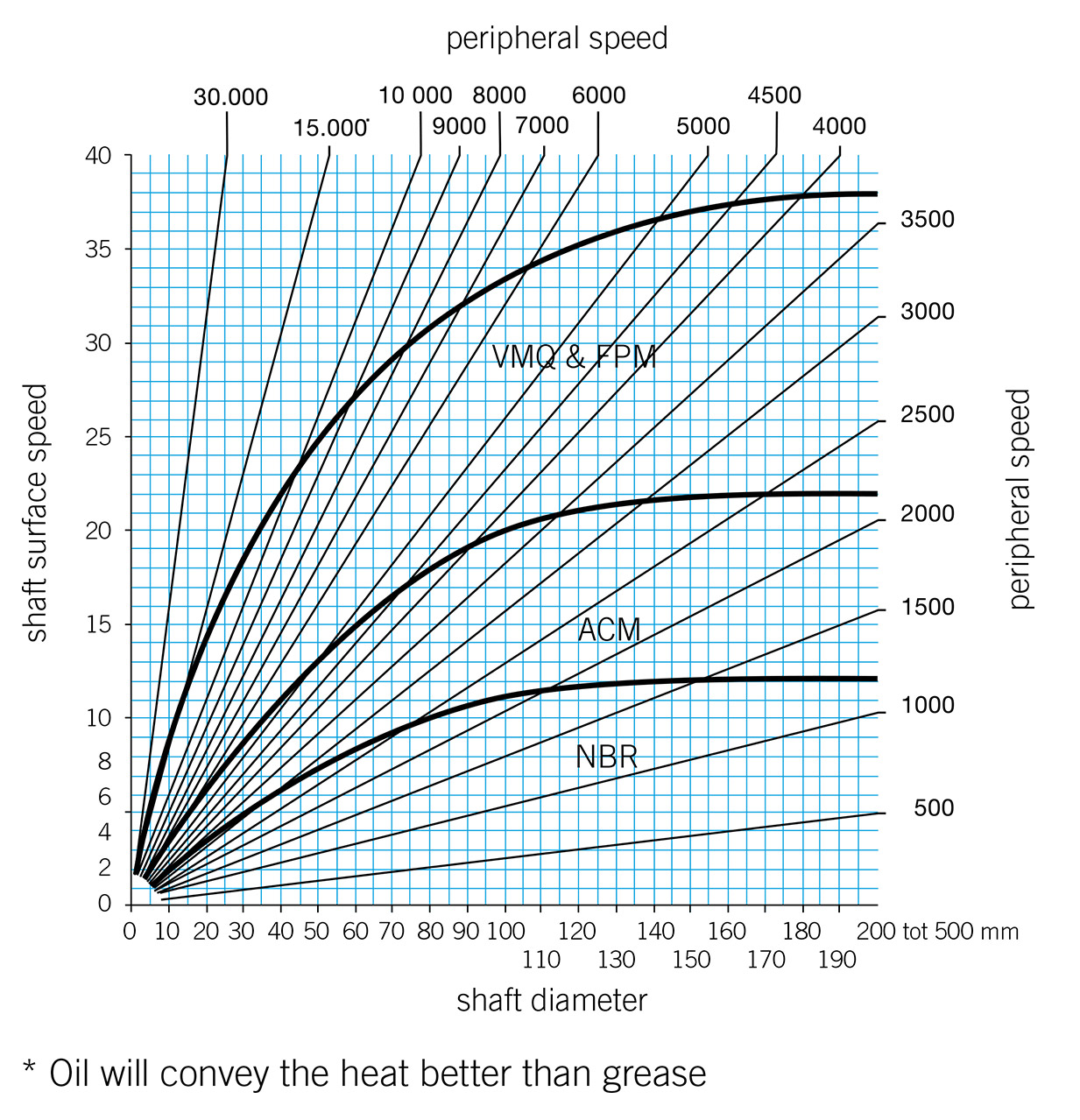The Ultimate Guide to Oil Seals
The Ultimate Guide to Oil Seals
Oil seals are found in a wide range of applications, in virtually every industrial sector. It is essential to select the correct oil seal so that the application in which it is used can run efficiently, free of leaks or other issues. In this blog, we explain which factors you should pay attention to when selecting the best oil seal for your application.
Oil seal specifications
The group of oil seals used in dynamic applications include radial shaft seals that seal a rotating shaft around its circumference. They are also known as lip seals, but in this blog we will use the term oil seals.
Usually, these oil seals are used to seal lubricating oil or grease and contain it within the application, so that moving parts such as bearings are continually supplied with enough lubrication. However, such seals are also used for sealing other liquids, gases, and solids, such as powders or granules.
An oil seal consists of:
- An outer case, a body made of metal or provided with a rubber layer
- A rubber or PTFE sealing lip
- A spring, the composition of which depends on the type

The lip is specially designed to ensure the oil seal works effectively with the different forces that arise during rotation. Many different designs and materials are used, so countless types of oil seals are available. These are chosen according to the application; pumps, gearboxes, wheels, and many other rotating applications where fluids need to be sealed. They are used in a variety of sectors, such as the chemical industry, manufacturing, wind turbines, automotive sector, food industry, and more. Oil seals are used in nearly all sectors.
Choosing the right oil seal
What should you take into account when selecting an oil seal? Different types of oil seals and various types of materials are available, each designed for specific uses. It is also important to select the right size of oil seal for the best results. For this reason, selecting the right oil seal requires adequate understanding of the application in which it will be used.
Engine Crankshaft Oil Seal 9031683001
Oil seal type or shape
Most standard oil seals have to comply with the DIN 3760 and ISO 6194 standards. Different standard types of oil seals are available that comply with these requirements.
The most common oil seals are the ERIKS types R, RST, M and MST, which correspond respectively to types A, AS, B and BS according to DIN 3760/ISO 6194.
All are fitted with a spring to preload the sealing lip. All these types are for non-pressurised or low-pressure applications up to 0.5 bar for diameters of a limited size. For diameter of 500 mm or more, the maximum pressure is 0.1 bar. For higher pressures, special types or PTFE lip seals can be used.
ERIKS type M (type B according to the DIN standard) has a single metal casing and rubber sealing lip. Since the casing is made of metal, it must be fitted in a well-finished, undamaged groove. Large volumes of oil seals with metal casings are often cheaper, which is why they are often used as original equipment in machines. However, if an oil seal has to be replaced, types with a rubber exterior (type R or RST) are easier to fit. Type MST is similar to M and commonly used. The difference is the dust lip in the MST oil seal that prevents dust and dirt reaching the sealing lip, and extends its service life in dusty environments.
ERIKS type GV (type C according to DIN) is equivalent to type M, but is a heavy-duty version with a double metal casing. This can be a useful solution with larger diameters in more demanding applications. There is also a version of this type with a dust lip; the GVST (type CS according to DIN).
ERIKS type R (type A according to the DIN standard) is identical in shape to type M, but has a rubber outer case with metal reinforcement on the inside. The rubber creates a good seal in the housing, even if the housing has suffered minor damage or is not in its best condition for other reasons. The RST version has a dust lip. These types are often chosen to replace a type with a metal outer case because they are easier to install and can cope with minor damage to the groove, such as scratches.
ERIKS also supplies the types GR and GRST. These are virtually identical to the types R and RST, except in this case the metal inner ring is also completely encased in rubber. ERIKS uses FKM rubber here as standard, so these seals are ideal for use in acidic environments.
An overview of the different standard types of oil seals and their main characteristics is shown below.
Oil seal material
Outer case
- Metal
The metal used in the outer case of oil seals is usually made of carbon steel. Upon request, and depending on quantities, a different type of steel (such as stainless steel) can be used.
- Rubber or rubber fabric
The quality of the rubber or rubber fabric used to make an outer case is the same as the quality of the rubber sealing lip. Fabric reinforced rubber is, as the name suggests, rubber reinforced with a fabric.
Spring
Standard springs are made of carbon steel. We use stainless-steel springs for our GR and GRST oil seals made from FKM rubber. In some rare cases, an O-ring is even used as a spring element. Standard PTFE lip seals are not fitted with springs.
Sealing lip
The sealing lip is always made of a rubber or synthetic material. For oil seals with a rubber outer case (R, RST, GR, GRST), the rubber quality of the sealing lip and the outer case are the same.
The material of the sealing lip is chosen according to the liquid to be sealed and the rotational speed. For larger shafts, an NBR sealing lip can cope with surface speeds of up to 10-12 m/s, while an FKM lip is suitable for speeds of up to 35-38 m/s.

Nitrile Butadiene Rubber (NBR, nitrile)
NBR, also known as nitrile rubber or nitrile, is the most popular material for an oil seal because of its good resistance to many oils and greases, such as mineral grease and hydraulic oil. Depending on their composition, synthetic oils and greases, such as those based on glycol, can damage NBR rubber materials. Depending on the amount of glycol, a PTFE lip seal may be the best choice. NBR is also unable to cope with contact with acids and solvents. The rubber is suitable for oil and grease at temperatures from -35 °C to 100 °C.
Most ERIKS oil seals, such as the types M, MST, R and RST, are made of NBR as standard.
Fluorine rubber (FKM, Viton™)
FKM or FPM, which is in well-known brand Viton™, can withstand higher liquid temperatures of up to 180 ˚C. FKM is highly resistant to strong acids and bases, as well as to synthetic oils and greases. Glycol-based oil and grease, however, can also damage FKM.
Because of the higher temperature resistance of FKM, this material is also chosen for applications where higher speeds play a role, which raise the temperature at the sealing lip considerably. Usually, using FKM will result in a longer life than using NBR. This compensates the higher price of FKM compared to NBR, as an FKM does not have to be replaced as frequently. The low temperature resistance of standard FKM is limited to -15 ˚C.
Polytetrafluoroethylene (PTFE, Teflon®)
PTFE, which is used in the well-known brand Teflon®, is less commonly used, but it is the preferred material for specific rotating seals in the chemical, food and pharmaceutical industries. This material is notable for having a very low frictional resistance and the best chemical resistance. It can also withstand a very wide range of temperatures in these types of seals; -80 ˚C to 200 ˚C. The shafts on which oil seals with PTFE lips are used require a harder and finer finish. Something like an axle sleeve can also be used to meet this requirement.
EPDM
EPDM oil seals are less common. They are used in solvent, hot water and steam applications, EPDM resists low temperatures down to -50 °C and UV radiation well. Some types of EPDM are also suitable for higher temperatures up to +150 °C. EPDM oil seals are usually available upon request.
VMQ (silicone)
VMQ, also known as silicone, is also used for oil seals, but this is less common because the mechanical strength of VMQ is low and this material has poor wear-resistance This makes it less suitable for dynamic applications, but it can withstand fairly low and high temperatures from -60 °C to 200 °C. Many types of VMQ are also suitable for contact with pharmaceutical and food products, so VMQ is an option worth considering. VMQ oil seals are usually available on request.
-
The Ultimate Guide to Car Repair Kits: Tools and Essentials Every Driver Should Own
News Aug.01,2025
-
The Complete Guide to Oil Pan Gaskets: Sealing Engine Leaks the Right Way
News Aug.01,2025
-
Preventing Oil Leaks: A Complete Guide to Oil Pan Gaskets and Drain Seals
News Aug.01,2025
-
Everything You Need to Know About Oil Pan Gaskets and Drain Plug Seals
News Aug.01,2025
-
Essential for Car Owners: How to Use a Car Repair Kit to Deal with Minor Breakdown
News Aug.01,2025
-
Comprehensive Guide to Engine Oil Sump Gaskets and Related Seals
News Aug.01,2025
-
The Ultimate Guide to Boat Propeller Bearings and Trailer Wheel Bearings
News Jul.31,2025
Products categories
















